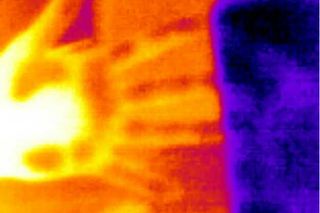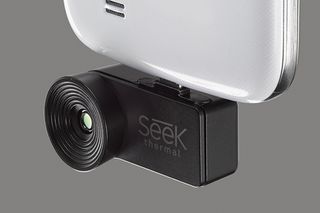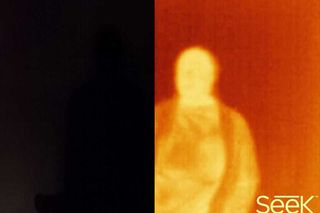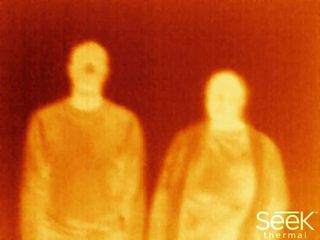Predator Vision: Seek Thermal Camera for Smartphones
In the past, thermal imaging has been largely limited to the military. Now Seek Thermal's $199 camera adds infrared vision to your phone.

Ever since I saw Predator as a child, I’ve had dreams of seeing the hidden heat signatures that go undetected by my primitive eyes. While the military has had access to this kind of technology for years, its price tag has been so high that normal consumers would never think of owning it. Until now. Seek Thermal has created a new camera that can plug into your smartphone to unveil images in the infrared spectrum, for just $199.
The Seek camera attaches directly to your Android or iOS smartphone via the micro USB or Lightning connector and when paired with the free app, allows you to see things in a whole new way. The closest thermal imaging competitor, FLIR, offers a 249 x 180 camera for around $3500, while Seek Thermal’s smartphone accessory features a resolution of 206 x 156 for under $200. The Seek camera can see differences in temperature from -40 Celsius up to 330c, although Seek admits that temperature readings above boiling can be less accurate, something it's working to improve.
MORE: The Best iPhone Camera Lenses 2014

While you may be wondering what use a thermal camera has besides hunting down Arnold Schwarzenegger, my hands-on time with the Seek Thermal camera revealed a wide range of uses. For example, you could use it to see which chairs have been sat in recently, possibly saving yourself the embarrassment of stealing your boss's seat. You can also measure the temperature of food and drinks to see if that coffee will burn your mouth or to judge whether that meal has been left for too long in the "danger zone" where bacteria breeds. Pet owners can also use the camera to see residual heat and find out if their animals stay off the “nice” couch, or if they revel in luxury as soon as you walk out of the room. You can see the result of residual heat on a water bottle (at right) just as I took my hand off of it.
There are also numerous industrial uses, like finding out where a certain pipe is clogged, or seeing where the heat is building up in your new desktop computer.
Easy and fun to use
Operation is dead simple. All you have to do is plug the Seek camera into the micro USB port on your device (or Lightning connector for iPhones), and open up the app. The app uses your phone’s display as a viewfinder, and can even use your phone’s camera to give you a dual view image with visible-light and thermal views side-by-side.

In the image above, taken in a dark room, I pulled a slider to the right to show only half the scene in infrared. The image below shows the entire scene as Predator would view it.
Sign up to get the BEST of Tom’s Guide direct to your inbox.
Upgrade your life with a daily dose of the biggest tech news, lifestyle hacks and our curated analysis. Be the first to know about cutting-edge gadgets and the hottest deals.

You can also set thermal thresholds, so that the camera will only show heat above, below or equal to a specified temperature. This makes it easy to highlight exposed skin or determine if your drink needs more ice.
There are still a few issues, though. Among Android phones, only the Motorola Moto X, Moto G and recent Samsung Galaxy phones are officially supported, but theoretically almost every Android device should work. My HTC One M7 is not one of them, however, because its micro USB port faces the wrong way, turning the Seek into an infrared selfie cam. A swivel USB plug or an adapter would be helpful here. The Seek also refused to work with a Kyocera Brigadier (although that's hardly a mainstream Android model). The app also crashed several times during my hands-on, but I didn’t lose any pictures, and app was quick to restart. That being said, I was using a pre-production unit, and overall I was impressed with the Seek's ease of use.
For me, the best use of Seek’s camera is simply its ability to change how I think about vision — and to pretend I belong to a legendary race of space-faring warriors.
- Our Favorite Smartphone Cameras 2014
- Photography of the Future:10 Wild Camera Concepts
- Best Waterproof and Rugged Cameras 2014
Sam Rutherford is a Staff Writer at Tom’s Guide. Follow him @SamRutherford on Twitter and Google+. Follow us @Tom’s Guide on Facebook and Google+
Sam is a Senior Writer at Engadget and previously worked at Gizmodo as a Senior Reporter. Before that, he worked at Tom's Guide and Laptop Mag as a Staff Writer and Senior Product Review Analyst, overseeing benchmarks and testing for countless product reviews. He was also an archery instructor and a penguin trainer too (really).
